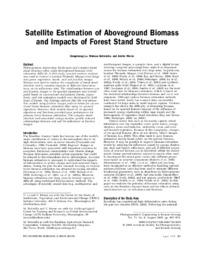Satellite estimation of aboveground biomass and impacts of forest stand structure.
Satellite estimation of aboveground biomass and impacts of forest stand structure.
Author(s): LU, D.; BATISTELLA, M.; MORAN, E.
Summary: Heterogeneous Amazonian landscapes and complex forest stand structure often make aboveground biomass (AGB) estimation difficult. In this study, spectral mixture analysis was used to convert a Landsat Thematic Mapper (TM) image into green vegetation, shade, and soil fraction images. Entropy was used to analyze the complexity of forest stand structure and to examine impacts of different stand structures on TM reflectance data. The relationships between AGB and fraction images or TM spectral signatures were investigated based on successional and primary forests, respectively, and AGB estimation models were developed for both types of forests. Our findings indicate that the AGB estimation models using fraction images perform better for successional forest biomass estimation than using TM spectral signatures. However, both models based on TM spectral signatures and fractions provided poor performance for primary forest biomass estimation. The complex stand structure and associated canopy shadow greatly reduced relationships between AGB and TM reflectance or fraction images.
Publication year: 2005
Types of publication: Journal article
Unit: Embrapa Territorial
Keywords: Florestas, Impacto Ambiental, Machadinho D´Oeste, Rondônia, Vegetação
Observation
Some of Embrapa's publications are published as ePub files. To read them, use or download one of the following free software options to your computer or mobile device. Android: Google Play Books; IOS: iBooks; Windows and Linux: Calibre.
Access other publications
Access the Agricultural Research Database (BDPA) to consult Embrapa's full library collection and records.
Visit Embrapa Bookstore to purchase books and other publications sold by Embrapa.

